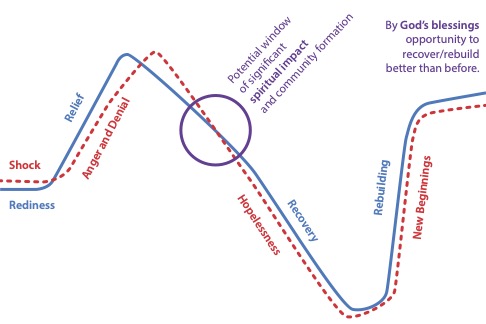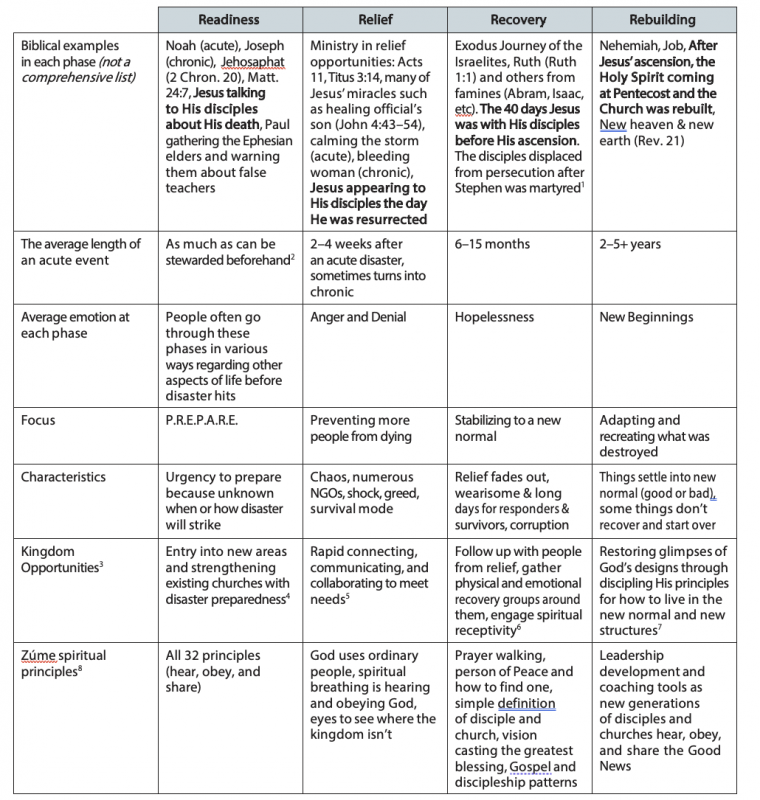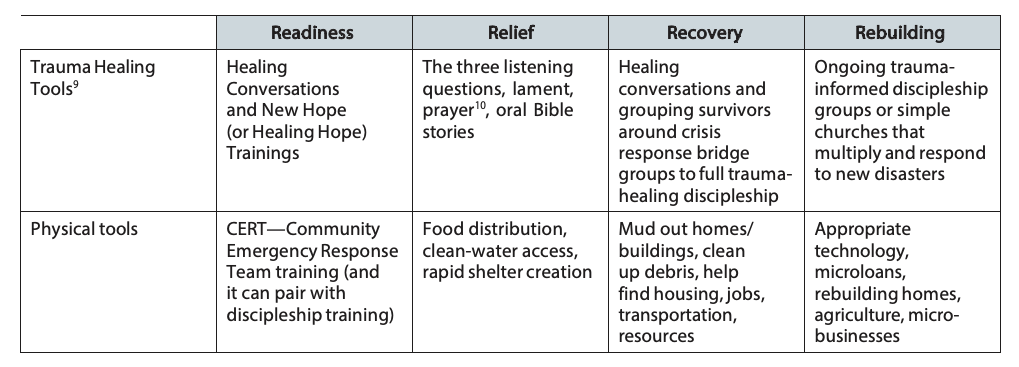P.R.E.P.A.R.E. to Respond to Crisis

“What we do is not because there is a need, but because there is a God.”
—Dr. Alicia Britt Chole
When walking the streets after disasters in several nations, including my own, I often asked people: “Was there a time when you cried out to God?” Time and time again, they would say “Yes.” In their darkest, scariest moments, people are often shaken to realize there may be more to life than what they have been living. When we share stories about God and the Gospel, it answers their desperate prayers with Good News—from the God to whom their inmost being had cried out.
How can we position ourselves to be ready for the opportunities God gives us? How can we join Him in caring for people through the phases of disaster response, for the long-term advancement of His kingdom through multiplying disciples and churches who transform communities?
One way is to P.R.E.P.A.R.E. to recover God’s designs out of disasters: knowing Him, making Him known, and living by kingdom principles according to Scripture. Whether our focus is across an ocean or across the street, we can prepare locally, regionally, and/or globally to increase effectiveness to be able to love others well in Jesus’ name.
Posture | Research | Equipping | Processes |
Assessment | Response |
Establishing multiplying disciples & churches
Walking through Scriptures, stories, and scenarios as we P.R.E.P.A.R.E. can make a significant difference. It may be as simple as changing the questions we ask, as phases, information, and circumstances change. From micro (individual) to macro (network) levels, it is important to get the basics in place in order to lead to the long-term vision of movement efforts. Caring for an individual experiencing a crisis is then multiplied to caring for entire communities, nations, and regions experiencing crises. While large-scale responses contain added dynamics of complexities, the same basics exist at the smallest fractal level.
We must be led by Scripture and the Spirit, not the demands of urgent needs or the deception of feeling better if we help just one more person. Scriptures sustain us through suffering when strategies or stories alone fall short. Our response to suffering should be formed before we experience it, in order to effectively see and join God in crisis. Action is crucial, but so also is heart response, and the way we do what we do.
One of the greatest gifts we can bring to those suffering and afflicted is a sense of, “Peace, be still.” Into the pain of those searching desperately, we have the privilege of offering the peace that only Jesus can bring—while we do whatever we do.
What if we read Scripture through the lens of crisis and disaster? God consistently transforms the most destructive moments into the most redemptive stories. In the New Testament, the movement of God thrived in the context of multiple crises, such as persecution (Acts 8:1), famines (Acts 11:28-30), urgent needs (Titus 3:14), death (Luke 8:49-56), sickness (Luke 8:43-48), riots (2 Cor. 6:4-5), and storms (Luke 8:22-25). The accounts of responses to disasters and crises were written to all the followers of Jesus. Still today, engaging in trauma healing and spiritual receptivity with reproducible tools is transferable across all cultures at the baseline level.
P.R.E.P.A.R.E
Posture—How can you build a scriptural foundation to stand on in the face of suffering? What Scriptures do you need to write on your mind and engrave in your heart, to have on your lips in the midst of a crisis (Deut. 11:18-19)?
Research—What types of disasters is your area vulnerable to? What skills and resources do the disciples, churches, and communities around you have? What supplies and skills do you all need to develop?
Equipping—What are the trauma-healing and physical-response skills that can be multiplied alongside the spiritual tools? In what ways can you equip small groups of people to hear, obey, and pass on these tools—for their own resilience and strengthening one another?
Processes—From individual to network-wide, what principles will shape how groups of disciples and churches will make decisions? Communicate? Problem-solve? What processes can you put in place ahead of time?
Assessment—What are a few simple questions that can help people assess the surrounding physical, emotional, and spiritual states? In what ways can continuous (formal and informal) assessment help?
Response—In what ways can ordinary people in churches join God at work in each phase of disaster response: readiness, relief, recovery, and rebuilding? How can you connect, communicate, and collaborate with various professional skills and resources, with the main resource being ordinary people?
Establishing multiplying disciples & churches What will be your plan to respond rapidly with a long-term vision? How will the disciples and churches sustain the response through the four phases?
What could your families of disciples and churches put into action and pass on to others to P.R.E.P.A.R.E.?
If you read the P.R.E.P.A.R.E. template with “you” as singular, go back through and read with “you” in the plural form: “we.” How does it change your response?
Understanding the response phases is foundational to any strategic-planning and decision-making processes. The more you can access real-time information on the ground, asking questions appropriate to the phases, the more helpful your response efforts can be.



More resources, including examples of P.R.E.P.A.R.E., can be found at: www.GodinCrisis.vision
To learn how to partner with Kingdom Movements serving in crisis/disasters, you can write to [email protected]









comments